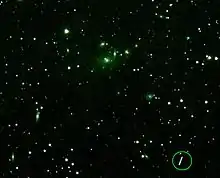 Asteroid Maria passing near a cluster of galaxies as seen by a four inch telescope over a period of nearly two hours. | |
| Discovery | |
|---|---|
| Discovered by | J. Perrotin |
| Discovery date | 10 January 1877 |
| Designations | |
| (170) Maria | |
| Pronunciation | /məˈriːə/ mə-REE-ə |
| A877 AA; 1958 AC | |
| Main belt (Maria) | |
| Orbital characteristics[1] | |
| Epoch 31 July 2016 (JD 2457600.5) | |
| Uncertainty parameter 0 | |
| Observation arc | 116.69 yr (42622 d) |
| Aphelion | 2.7161 AU (406.32 Gm) |
| Perihelion | 2.3923 AU (357.88 Gm) |
| 2.5542 AU (382.10 Gm) | |
| Eccentricity | 0.063388 |
| 4.08 yr (1491.0 d) | |
| 88.062° | |
| 0° 14m 29.184s / day | |
| Inclination | 14.377° |
| 301.34° | |
| 159.21° | |
| Earth MOID | 1.4114 AU (211.14 Gm) |
| Jupiter MOID | 2.39948 AU (358.957 Gm) |
| TJupiter | 3.392 |
| Physical characteristics | |
| Dimensions | 44.30±1.0 km |
| 13.120 h (0.5467 d) | |
| 0.1579±0.007 | |
| S[2] | |
| 9.39 | |
Maria (minor planet designation: 170 Maria) is a Main belt asteroid that was discovered by French astronomer Henri Joseph Perrotin on January 10, 1877.[3] Its orbit was computed by Antonio Abetti, and the asteroid was named after his sister, Maria. This is the namesake of the Maria asteroid family; one of the first asteroid families to be identified by Japanese astronomer Kiyotsugu Hirayama in 1918.[4]
In the Tholen classification system, this is categorized as a stony S-type asteroid.[2] Observations performed at the Palmer Divide Observatory in Colorado Springs, Colorado during 2007 produced a light curve with a period of 13.120 ± 0.002 hours and a brightness range of 0.21 ± 0.02 in magnitude. Previous measurements from 2000 gave 13.14 and 5.510 hour estimates for the period.[5] Based upon its spectrum, it is classified as an S-type asteroid.
An occultation of a star by Maria was observed from Manitoba, Canada, on June 10, 1997.
References
- ↑ Yeomans, Donald K., "170 Maria", JPL Small-Body Database Browser, NASA Jet Propulsion Laboratory, archived from the original on 27 January 2016, retrieved 12 May 2016.
- 1 2 DeMeo, Francesca E.; et al. (July 2009), "An extension of the Bus asteroid taxonomy into the near-infrared" (PDF), Icarus, vol. 202, no. 1, pp. 160–180, Bibcode:2009Icar..202..160D, doi:10.1016/j.icarus.2009.02.005, archived from the original (PDF) on 17 March 2014, retrieved 8 April 2013. See appendix A.
- ↑ "Numbered Minor Planets 1–5000", Discovery Circumstances, IAU Minor Planet center, archived from the original on 13 February 2012, retrieved 7 April 2013.
- ↑ Veeder, G. J.; et al. (March 1995), "Eos, Koronis, and Maria family asteroids: Infrared (JHK) photometry" (PDF), Icarus, vol. 114, pp. 186–196, Bibcode:1995Icar..114..186V, CiteSeerX 10.1.1.31.2739, doi:10.1006/icar.1995.1053.
- ↑ Warner, Brian D. (September 2007), "Asteroid Lightcurve Analysis at the Palmer Divide Observatory", The Minor Planet Bulletin, Bibcode:2007MPBu...34...72W.
External links
- Lightcurve plot of 170 Maria, Palmer Divide Observatory, B. D. Warner (2007)
- Asteroid Lightcurve Database (LCDB), query form (info Archived 16 December 2017 at the Wayback Machine)
- Dictionary of Minor Planet Names, Google books
- Asteroids and comets rotation curves, CdR – Observatoire de Genève, Raoul Behrend
- Discovery Circumstances: Numbered Minor Planets (1)-(5000) – Minor Planet Center
- 170 Maria at AstDyS-2, Asteroids—Dynamic Site
- 170 Maria at the JPL Small-Body Database